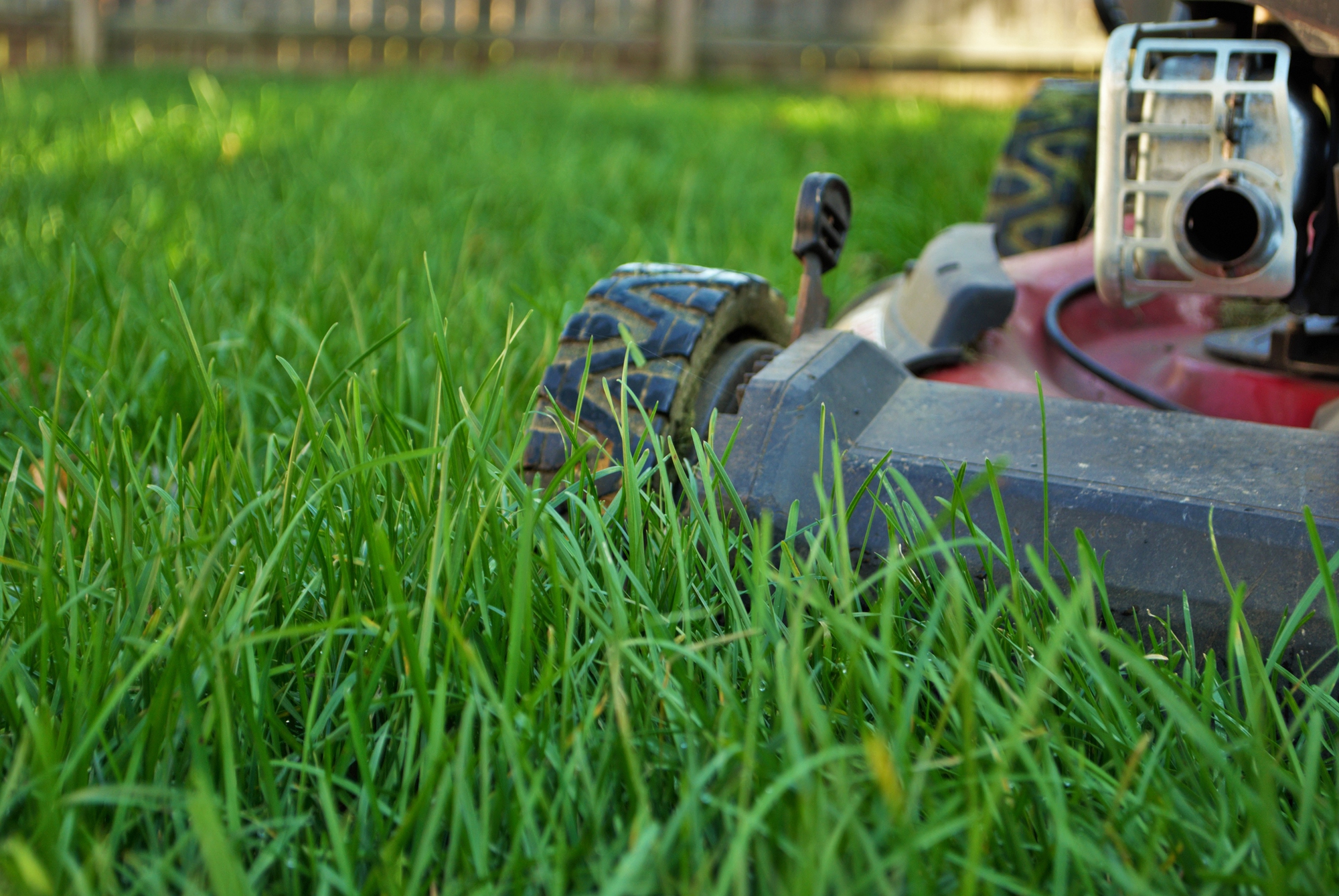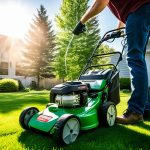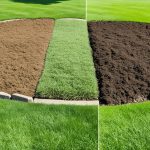Summer lawn care often raises questions about proper mowing practices. As temperatures rise, the height at which you cut your grass becomes increasingly important for maintaining a healthy, resilient lawn. Many homeowners make the mistake of cutting their grass too short, especially during hot weather.
For most cool-season grasses like Kentucky bluegrass, tall fescue, and perennial ryegrass, the ideal mowing height during summer months is between 7.5-10 cm.
Warm-season grasses such as Bermuda and Zoysia can typically be cut shorter, around 2.5-5 cm, even in summer heat. This taller grass length provides shade to the soil, reduces water evaporation, and helps prevent weed growth.
Adjusting your mowing schedule and technique is just as important as the height. During summer, it’s best to mow in the early morning or evening when temperatures are cooler, and never remove more than one-third of the grass blade in a single mowing session to prevent stress to your lawn.
Key Takeaways
- Maintain cool-season grasses at 7.5-10 cm and warm-season grasses at 2.5-5 cm during summer months for optimal health.
- Taller grass shades soil, conserves moisture and reduces weed competition during hot weather.
- Mow during cooler parts of the day and follow the one-third rule to minimise stress on your lawn.
Understanding the Importance of Mowing Height for Summer Lawn Care
The height at which you cut your grass plays a vital role in maintaining a healthy lawn during the hot summer months. Proper mowing height helps grass withstand heat stress, reduces weed competition and promotes deeper root development.
How Cutting Height Affects Healthy Grass Growth
Grass height directly influences root development. When grass is cut too short, the root system becomes shallow, making the lawn more vulnerable to drought and heat stress. Taller grass develops deeper roots that can access water stored further in the soil profile.
Proper cutting height also affects the grass’s ability to photosynthesise. Longer grass blades have more leaf surface area to capture sunlight and produce the energy needed for growth and recovery. This increased energy production helps grass bounce back from stress more quickly.
Different grass types have different ideal heights. Cool-season grasses like fescue and ryegrass generally benefit from being kept taller (7-10 cm) in summer, while warm-season varieties like Bermuda grass can tolerate shorter heights (2.5-5 cm).
Seasonal Challenges for Lawns in Summer
Heat stress is a primary concern during summer months. When temperatures rise above 26°C, many grass types slow their growth and enter a semi-dormant state. At this time, cutting grass too short exposes soil to direct sunlight, increasing evaporation and soil temperature.
Water scarcity often compounds summer stress on lawns. Taller grass shades the soil, reducing evaporation and helping retain precious moisture. This shade also helps suppress weed germination by blocking light from reaching weed seeds.
Disease pressure increases during hot, humid summer conditions. Proper mowing height helps grass maintain natural defences against fungal pathogens that thrive in summer weather.
Foot traffic causes additional stress on summer lawns. Longer grass provides more cushioning and protection for crown tissue (the growing point at the base of grass plants) during periods of heavy use.
Balancing Lawn Maintenance and Plant Health
The ‘one-third rule’ provides a useful guideline for summer mowing: never remove more than one-third of the grass blade height in a single mowing. This prevents shock to the plant and allows for quicker recovery.
Mowing frequency should adjust with growth rate. During peak summer heat, grass often grows more slowly, so weekly mowing may become fortnightly mowing. Cutting grass when it’s dry rather than wet results in cleaner cuts and reduces disease spread.
Sharp mower blades are essential for lawn health. Dull blades tear rather than cut grass, creating ragged edges that lose more moisture and provide entry points for disease. Sharpen blades at least twice during the growing season.
Consider raising your mower height by 1-2 cm during the hottest parts of summer. This small adjustment can significantly improve your lawn’s resilience to heat stress without creating an unkempt appearance.
Best Mowing Heights for Different Grass Types
Different grass types have specific mowing height requirements to maintain their health and appearance during summer months. The correct height helps grass develop deeper roots and better withstand heat and drought stress.
Recommended Height for Cool-Season Grasses
Cool-season grasses perform best when cut higher during summer heat. Taller grass shades soil, reducing moisture loss and weed competition.
Kentucky bluegrass thrives when mowed to 6.5-7.5 cm in summer, which is higher than its spring height of 5-6 cm. This extra length helps protect roots from scorching temperatures.
Tall fescue should be maintained at 7.5-10 cm during hot months. The additional height supports its naturally deep root system and helps it stay green even during dry periods.
Ryegrass performs well when kept at 6.5-7.5 cm in summer. Like other cool-season varieties, a taller height gives it better heat tolerance.
Pro tip: Never remove more than one-third of the leaf blade in a single mowing session to avoid stressing these grasses during summer.
Optimal Height for Warm-Season Grasses
Warm-season grasses typically prefer lower cutting heights than their cool-season counterparts, even during summer months.
Bermuda grass varieties perform best when maintained at 2.5-5 cm, with hybrid types preferring the shorter end of this range. Common Bermuda tolerates slightly higher cuts.
Zoysia grass should be cut to about 2.5-5 cm, depending on the specific variety. Fine-bladed zoysia types often look best at the lower end of this range.
These grasses have evolved to thrive in hot weather, so they don’t require the extra height for temperature protection that cool-season varieties need.
A shorter mowing height for warm-season grasses produces denser turf that stands up better to foot traffic and helps prevent weed germination.
Specific Mowing Heights for Bluegrass, Fescue, Ryegrass, Bermuda and Zoysia
| Grass Type | Summer Mowing Height (cm) | Benefits |
|---|---|---|
| Kentucky Bluegrass | 6.5-7.5 | Better drought resistance, reduced scalping risk |
| Tall Fescue | 7.5-10 | Enhanced heat tolerance, deeper root development |
| Ryegrass | 6.5-7.5 | Improved shade tolerance, reduced browning |
| Bermuda | 2.5-5 | Denser growth, better wear resistance |
| Zoysia | 2.5-5 | Fewer scalping issues, better weed control |
The exact height within these ranges depends on factors like local climate and lawn use. For heavily used areas, stay at the higher end of the recommended range.
Remember to sharpen mower blades regularly. Dull blades tear grass instead of cutting cleanly, creating entry points for disease and increasing water loss from ragged leaf tips.
For partially shaded areas, adjust heights toward the upper end of the recommended range. Grass in shade needs more leaf surface to capture limited light.
Proper Lawn Mowing Techniques in Hot Weather
Adjusting your mowing approach during summer heat is essential for maintaining a healthy lawn. The right techniques can help grass withstand stress from high temperatures while promoting proper growth and root development.
Guidelines for Mowing Your Lawn During Summer
The timing of your mowing sessions becomes critical during hot weather. Early morning or late evening are the best times to cut grass in summer, as temperatures are lower. This reduces stress on both the grass and the person operating the mower.
Raise your cutting height in summer to between 7-10 cm (3-4 inches) for most grass types. Taller grass shades the soil, keeping it cooler and reducing water evaporation. It also encourages deeper root growth, helping lawns access water from lower soil levels.
Never remove more than one-third of the grass blade height in a single mowing session. Taking too much at once weakens the grass and makes it more vulnerable to heat stress and disease.
Consider leaving grass clippings on the lawn (known as “grasscycling”). These clippings quickly break down, returning valuable nutrients to the soil and providing a natural cooling effect.
Using a Rotary Mower Effectively
A rotary mower works best when the grass is dry. Wet grass can clog the cutting deck and create uneven cuts. Check weather forecasts to plan mowing sessions when rain isn’t expected.
Adjust your mowing pattern regularly, alternating between different directions (north-south one week, east-west the next). This prevents grass from leaning in one direction and helps avoid soil compaction from repeated wheel tracks.
Clean your rotary mower after each use. Remove grass build-up from the underside of the deck and around the blades. This prevents grass disease spread and maintains cutting efficiency.
Move at a steady, moderate pace when operating the mower. Going too fast can result in missed patches and uneven cutting, while moving too slowly might lead to over-cutting certain areas.
Maintaining Sharp Blades and Correct Blade Height
Sharp mower blades are essential for clean cuts that heal quickly. Dull blades tear rather than slice grass, creating ragged edges that lose moisture rapidly and become entry points for disease.
Inspect and sharpen your mower blades at least 2-3 times during the summer season. You’ll know blades need sharpening when grass tips appear brown or shredded after mowing.
Set blade height consistently across the mower deck. Uneven blade settings result in an irregular lawn surface with some areas cut too short, making them vulnerable to heat stress.
Always turn off and disconnect the mower before adjusting or maintaining blades. Wear heavy gloves when handling blades to prevent injuries. Replace severely damaged or worn blades rather than continuing to sharpen them.
Managing Lawn Clippings and Mulching for Summer Health
Proper management of grass clippings during summer months provides natural nutrients and moisture retention benefits for your lawn. The way you handle these clippings can significantly affect lawn health during hot weather.
Benefits of Leaving Clippings on the Lawn
Grass clippings contain valuable nutrients that can nourish your lawn naturally. When left on the grass, clippings can provide up to 25% of your lawn’s nitrogen needs, reducing the amount of fertiliser required.
These clippings break down quickly in warm summer weather, typically decomposing within 1-2 weeks. This natural decomposition adds organic matter to the soil, improving its structure and water-holding capacity.
Leaving clippings also saves time and effort. There’s no need to bag and dispose of grass, making mowing faster and more straightforward.
Research shows lawns with returned clippings tend to be more drought-resistant. The clippings act as a light mulch layer that helps reduce water evaporation from the soil surface.
Effective Mulching Practices
Using a proper mulching mower makes a significant difference in how effectively clippings break down. These specialised mowers cut grass into smaller pieces that decompose more quickly.
For best results, remove no more than one-third of the grass blade length in a single cutting. This creates finer clippings that filter down to soil level rather than sitting on top of the lawn.
Keep mower blades sharp. Dull blades tear grass rather than cut it cleanly, creating ragged clippings that break down more slowly.
Mow when the grass is dry for better clipping distribution. Wet clippings tend to clump together, creating unsightly patches that can smother the lawn below.
Consider mowing more frequently during peak growth periods. This produces shorter clippings that decompose more efficiently.
When to Remove Excess Clippings
If your lawn has grown excessively tall, collecting clippings may be necessary. Thick mats of long clippings can block sunlight and air from reaching the grass below.
During disease outbreaks, removing clippings helps prevent the spread of pathogens throughout the lawn. This is particularly important for fungal diseases common in humid summer conditions.
Heavy rain followed by mowing often produces wet, clumpy cuttings. These should be removed as they can suffocate grass patches and create ideal conditions for disease development.
If you’ve applied herbicides recently, collect clippings for the next 2-3 mowings. This prevents any chemical residue from affecting soil health or beneficial organisms.
Consider composting removed clippings rather than sending them to landfill. After proper decomposition, they make excellent garden fertiliser.
Supporting Grass Recovery and Growth After Mowing
Proper care after mowing is essential for maintaining a healthy lawn throughout summer. The actions you take immediately following mowing can significantly impact how well your grass recovers and continues to thrive during hot weather.
Watering and Feeding Post-Mowing
Water your lawn deeply within 24 hours after mowing to help grass recover from cutting stress. Apply approximately 2.5-4 cm of water, which encourages deep root growth rather than shallow watering that leaves grass vulnerable to heat stress.
Morning watering (5-9 am) is best as it reduces evaporation and fungal disease risks. Evening watering can lead to moisture sitting on blades overnight, potentially causing disease.
Fertilising after mowing helps replenish nutrients, but timing matters. Apply a summer-formulated fertiliser with higher potassium content about 2-3 days after mowing.
Summer Watering Schedule:
- Sandy soil: Water every 3-4 days
- Clay soil: Water every 5-7 days
- Loamy soil: Water every 4-6 days
Reduce frequency during cooler periods and increase during heatwaves to support grass recovery.
Identifying Common Summer Lawn Issues
Heat stress often appears as wilting or discoloured patches after mowing. When grass turns a blue-grey shade and doesn’t spring back when walked on, it needs immediate water.
Scalping damage occurs when mowing too short, leaving brown patches that heal slowly. Raise your cutting height immediately if you notice this issue.
Fungal diseases become more common after mowing in humid summer conditions. Look for circular brown patches, white powdery spots, or thread-like growths on morning dew.
Insect activity might increase in weakened grass. Check for grubs by gently pulling on affected areas—if the turf lifts easily, grubs may be present.
Address these issues promptly after identifying them to prevent further lawn deterioration.
Encouraging Robust Grass Growth
Leave grass clippings on the lawn after mowing when possible. These clippings break down quickly in summer heat, returning valuable nutrients to the soil and reducing fertiliser needs by up to 25%.
Avoid heavy foot traffic on newly mowed lawns for at least 24 hours. This gives grass time to recover from the stress of cutting without additional pressure.
Consider applying a seaweed-based tonic after mowing to deliver trace elements and stimulate microbial activity in the soil. These treatments help grass recover faster.
For struggling areas, overseed after mowing with drought-tolerant grass varieties suitable for your region. Water lightly twice daily until new seedlings establish.
Aerate compacted soil areas 2-3 weeks after mowing to improve oxygen flow to roots and enhance water penetration, creating better conditions for recovery and growth.





